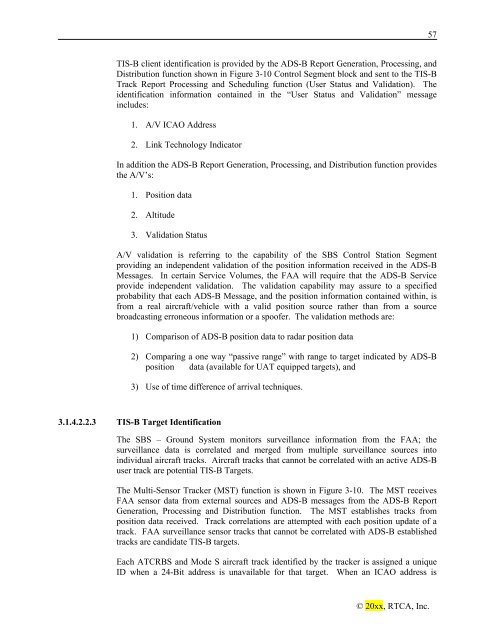Minimum Aviation System Performance Standards for Aircraft ...
Minimum Aviation System Performance Standards for Aircraft ...
Minimum Aviation System Performance Standards for Aircraft ...
Create successful ePaper yourself
Turn your PDF publications into a flip-book with our unique Google optimized e-Paper software.
TIS-B client identification is provided by the ADS-B Report Generation, Processing, and<br />
Distribution function shown in Figure 3-10 Control Segment block and sent to the TIS-B<br />
Track Report Processing and Scheduling function (User Status and Validation). The<br />
identification in<strong>for</strong>mation contained in the “User Status and Validation” message<br />
includes:<br />
1. A/V ICAO Address<br />
2. Link Technology Indicator<br />
In addition the ADS-B Report Generation, Processing, and Distribution function provides<br />
the A/V’s:<br />
1. Position data<br />
2. Altitude<br />
3. Validation Status<br />
A/V validation is referring to the capability of the SBS Control Station Segment<br />
providing an independent validation of the position in<strong>for</strong>mation received in the ADS-B<br />
Messages. In certain Service Volumes, the FAA will require that the ADS-B Service<br />
provide independent validation. The validation capability may assure to a specified<br />
probability that each ADS-B Message, and the position in<strong>for</strong>mation contained within, is<br />
from a real aircraft/vehicle with a valid position source rather than from a source<br />
broadcasting erroneous in<strong>for</strong>mation or a spoofer. The validation methods are:<br />
1) Comparison of ADS-B position data to radar position data<br />
2) Comparing a one way “passive range” with range to target indicated by ADS-B<br />
position data (available <strong>for</strong> UAT equipped targets), and<br />
3) Use of time difference of arrival techniques.<br />
3.1.4.2.2.3 TIS-B Target Identification<br />
The SBS – Ground <strong>System</strong> monitors surveillance in<strong>for</strong>mation from the FAA; the<br />
surveillance data is correlated and merged from multiple surveillance sources into<br />
individual aircraft tracks. <strong>Aircraft</strong> tracks that cannot be correlated with an active ADS-B<br />
user track are potential TIS-B Targets.<br />
The Multi-Sensor Tracker (MST) function is shown in Figure 3-10. The MST receives<br />
FAA sensor data from external sources and ADS-B messages from the ADS-B Report<br />
Generation, Processing and Distribution function. The MST establishes tracks from<br />
position data received. Track correlations are attempted with each position update of a<br />
track. FAA surveillance sensor tracks that cannot be correlated with ADS-B established<br />
tracks are candidate TIS-B targets.<br />
Each ATCRBS and Mode S aircraft track identified by the tracker is assigned a unique<br />
ID when a 24-Bit address is unavailable <strong>for</strong> that target. When an ICAO address is<br />
© 20xx, RTCA, Inc.<br />
57
















